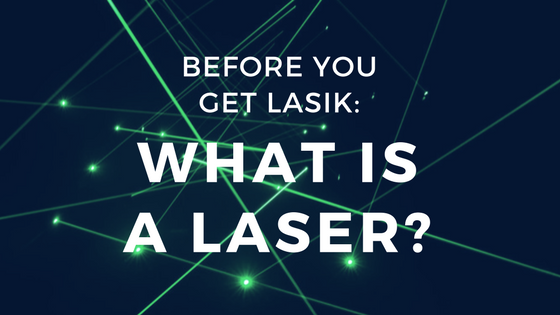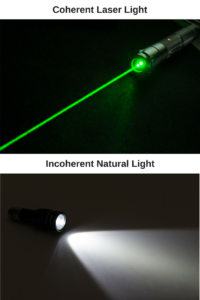
Thinking about LASIK surgery? We get it, there are a lot of questions. Aside from the common questions like “will it hurt?” or “how much does it cost?” there is a lot that people don’t ask about LASIK and how it works. You’ve heard all of these buzzwords and plenty of medical jargon, such as “100% bladeless, all laser LASIK!”, but rarely do people ask what that stuff actually means. At Loden, we’re as dedicated to patient education as we are to delivering top-notch care. So, in the spirit of knowledge, we answer the question: “What is a laser?”
The Basics: What a Laser Is Made Of
Before we dive into how our lasers at Loden Vision Centers work, let’s talk about what a laser actually is! Time for some science.
 The word “laser” is actually an acronym. It stands for “Light Amplification by Stimulated Emission of Radiation.” Light, as you may have heard, it made up of wavelengths. These wavelengths, as the name suggests, are shaped like waves and move like waves.
The word “laser” is actually an acronym. It stands for “Light Amplification by Stimulated Emission of Radiation.” Light, as you may have heard, it made up of wavelengths. These wavelengths, as the name suggests, are shaped like waves and move like waves.
A laser is an extremely concentrated beam of what’s called “coherent” light. Coherent light is very different from the natural light you’re used to seeing. Natural light (or incandescent light), such as from the sun, is made up of erratic, irregular wavelengths that don’t match up to each other. With lasers, these wavelengths match up and move in sync, making it coherent.
Think about turning on a flashlight. Does the light come out in a concentrated beam or does it appear as a wide shaft of light? This is because the light produced by a flashlight is considered “natural” light. The wavelengths are moving all over the place, resulting in a less concentrated beam of light.
Coherent light, which is what lasers are made up of, is “collimated”, meaning it travels in the same direction and can be concentrated on a single point. The fact that laser light is monochromatic, coherent and collimated means that it can be used to create a single beam of extremely powerful energy.
Not Your Average TV Laser
When you think of lasers, the first things that may pop into mind are the lasers you saw on that episode of that sci-fi drama series. You know, the ones that blow up planets or defeat aliens. It doesn’t take much thought to realize that these exact lasers don’t exist and certainly aren’t being used during LASIK surgery.
That’s not to say that extremely powerful lasers don’t exist. In fact, the U.S. Navy has lasers capable of shooting down enemy drones and missiles. In 2015, researchers in Japan fired one of the most powerful lasers in existence, which consisted of a 2-petawatt pulse (that’s 2 quadrillion, or 2,000 trillion watts). This laser pulse lasted for a trillionth of a second, and its 2-petawatt pulse held about 1,000 times more power than the entire world consumes in a year (which is 500 million terajoules). How’s that for perspective?
Lasers Used During LASIK in Nashville
Now that we’re done geeking out on big numbers and ultra powerful lasers, let’s get to the real reason you’re here. What about the lasers used during LASIK surgery?
There are two types of lasers used during bladeless LASIK surgery at Loden. The first is called a “femtosecond” laser. The second is called an “excimer” laser.
The femtosecond laser is used to create a thin “flap” on the surface of the cornea. A femtosecond laser delivers ultrashort pulses of energy. Unlike a microsecond laser, which is a long-pulse laser, the femtosecond laser delivers pulses of energy so short that there is no damage to the surface or surrounding areas of the object it’s being used on. The femtosecond laser creates thousands of tiny bubbles underneath the surface of your cornea, which allows a thin flap to be separated from your eye with no damage to the surface or surrounding tissues. When the flap is created, it leaves the inner portion of your cornea exposed for treatment. That’s where the excimer laser comes in!
The excimer laser is used to reshape your cornea, allowing for proper light refraction after surgery (AKA clear vision)! An excimer laser uses a form of ultraviolet light that is well absorbed by biological matter (i.e. your cornea). The excimer laser is used to remove tiny amounts of tissue from your cornea in order to reshape it. The excimer laser is remarkable in that it removes tissue without burning or cutting it. Essentially, the excimer laser uses its energy to disintegrate tiny amounts of tissue with no heat or damage to the tissue left intact. How cool is that?
LASIK Surgery at Loden
 Now that you have a good understanding of the technology involved in LASIK lasers, you can better understand the kinds of technology we offer at Loden in Nashville.
Now that you have a good understanding of the technology involved in LASIK lasers, you can better understand the kinds of technology we offer at Loden in Nashville.
Here at Loden, we only use the best of the best. That’s why we use the LASIK system. The LASIK system is comprised of all of the cutting edge technology you read about above, plus wavefront custom technology. Wavefront technology allows your Nashville LASIK surgeon to see a full view of the surface of your cornea. With this view, your surgeon knows exactly which areas of your cornea need treatment. This makes for a 100% individually customized procedure.
Interested in learning more about the LASIK technology at Loden? Want to experience it first hand? Schedule your LASIK consultation at one of our many locations in Nashville, Gallatin, Goodlettsville and more! We look forward to hearing from you.


